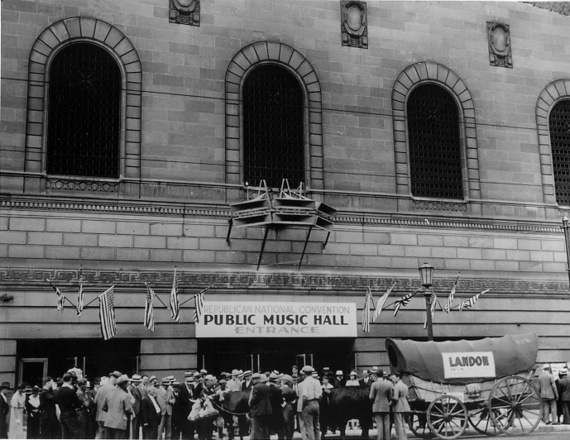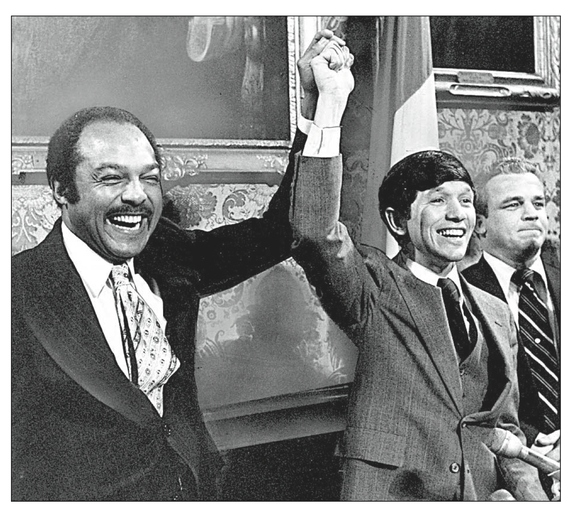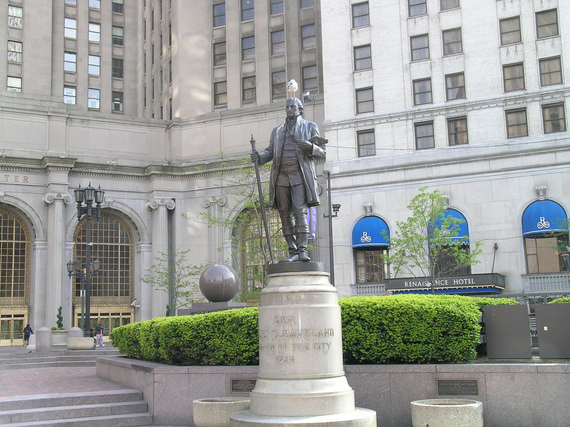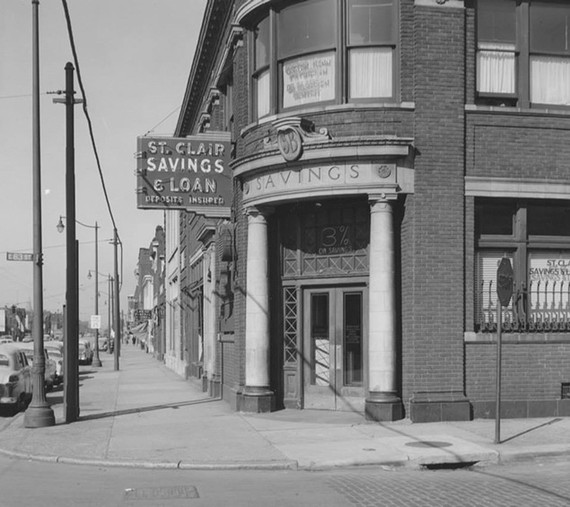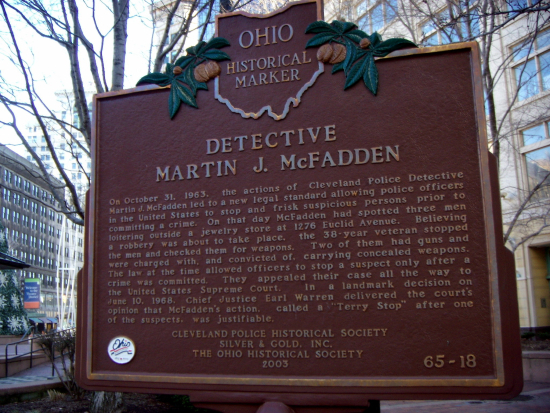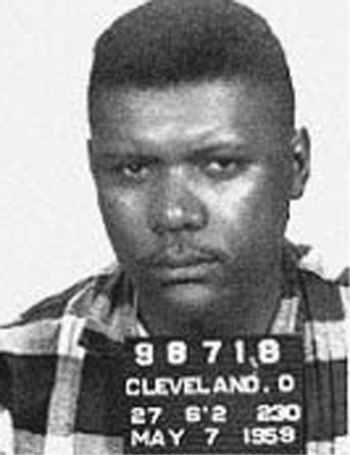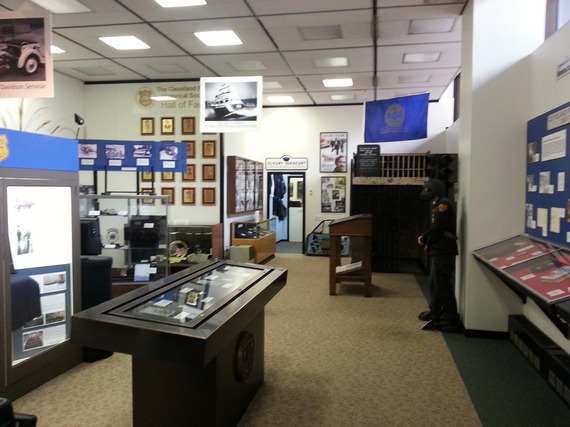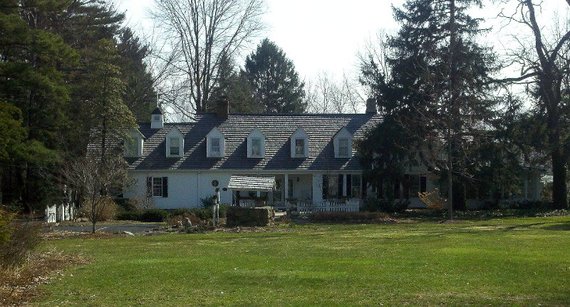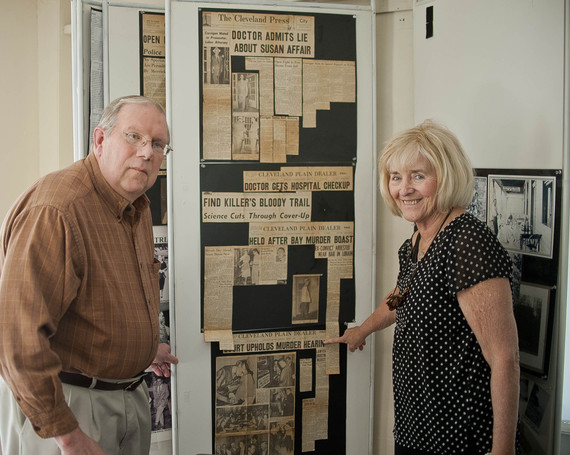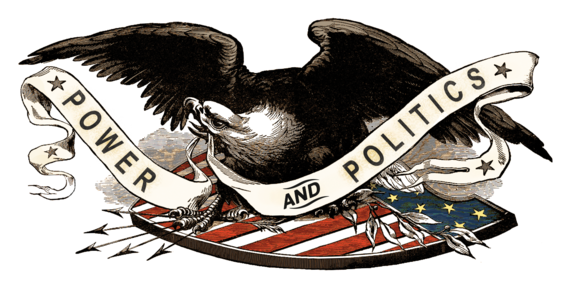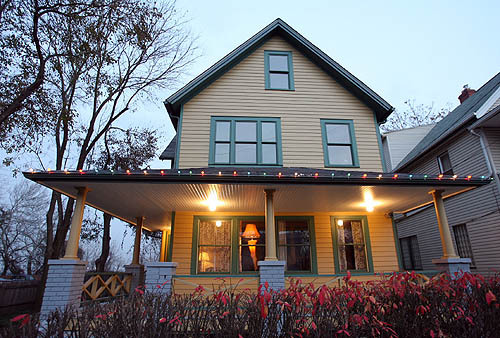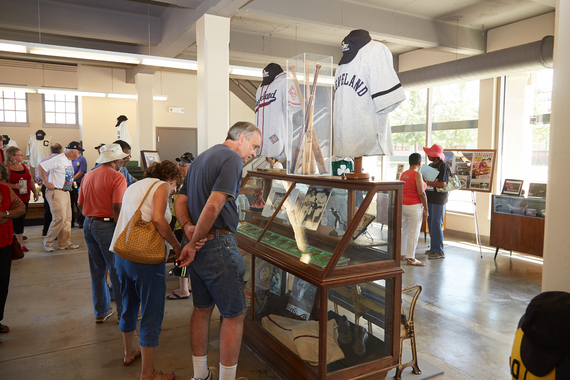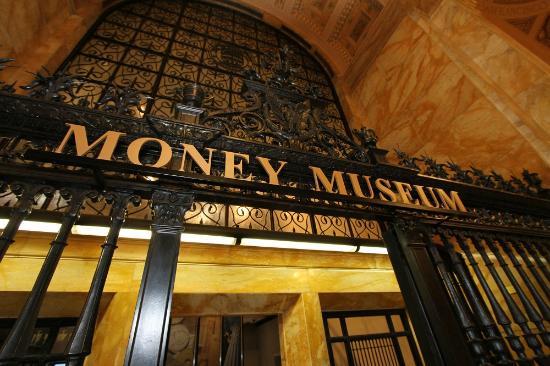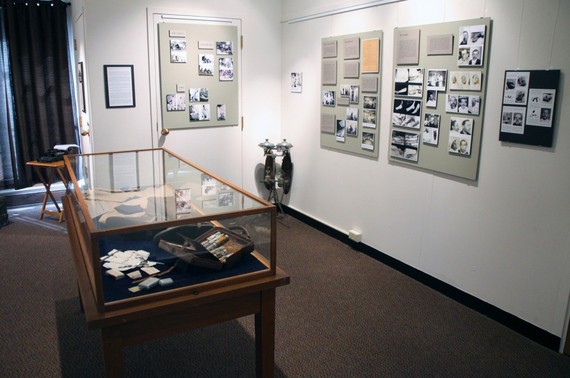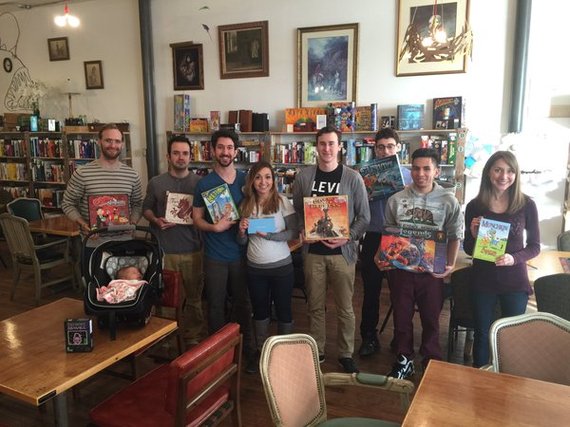The Alf Landon Bandwagon in front of Public Hall at the 1936 GOP Convention in Cleveland. Cleveland Public Library Photo
The Republicans have officially begun rolling into downtown Cleveland for the 2016 Presidential Convention which kicks off today and runs through Thursday, July 21.
It's really not much of a surprise that the city of Cleveland was selected to host the Republican National Convention.
Eight U.S. presidents, after all, were elected from Ohio, earning the state the nickname "the Mother of Presidents''; while Moreland Hills, a village in Cuyahoga County, is the birthplace of James A. Garfield (Republican), the 20th President.
And no Republican has won the presidency without winning the Buckeye State since Abraham Lincoln in 1860.
2016, of course, won't be the first year the Republicans selected Cleveland as their convention site. In 1924, they nominated Calvin Coolidge of Massachusetts at the Public Auditorium. In 1936, Alf Landon, the 26th governor of Kansas, was tapped at the same venue to face the formidable Franklin Delano Roosevelt.
Carl B. Stokes and Dennis J. Kucinich in 1979.
The city of Cleveland is also rich with generating political firsts.
In 1967, Carl B. Stokes, the great-grandson of a slave, was elected the first black mayor of a major city when he defeated Seth C. Taft, grandson of the 27th president, William Howard Taft.
And in 1977, City Councilman, Dennis J. Kucinich (aka ''Dennis the Menace''), only 32 and riding a wave of urban populism, was elected as the youngest mayor of a major city in the United States.
When thinking of Cleveland these days, most people immediately think of the Rock and Roll Hall of Fame and Museum (located on the shore of Lake Erie in downtown Cleveland), the Jack Cleveland Casino, (formerly Horseshoe Cleveland), located in the former Higbee Building at Tower City Center in downtown Cleveland, the internationally renowned Cleveland Museum of Art and the Cleveland Orchestra.
In addition to these fine venues and institutions, Cleveland, in fact, has a rich and diverse depository of local history tucked away in the deep recesses of the city that many often overlook.
A statue of Moses Cleaveland guards a corner of Public Square in front of the Terminal Tower in 2005.
The city's 10-acre Public Square, for instance, the central plaza of downtown Cleveland, (the location of the Soldiers and Sailors Monument and bronze statue of Moses Cleaveland, among other edifices) was where the public viewed the caskets of fallen Presidents Abraham Lincoln (1865) and James A. Garfield (1881).
Footnote: The first successful demonstration of electric streetlights lit up Public Square on April 29, 1879; and on Aug. 5, 1914, the world's first electric traffic signal was put into place on the corner of Euclid Ave. and East 105th Street, based on a design by James Hoge.
Many visitors are additionally surprised to learn that a public hanging took place at Public Square on June 24, 1812, when John O'Mic, a Chippewa Indian, became the first person executed in Cuyahoga County for the murder of Daniel Buel. With dark foreboding clouds looming, a large crowd reportedly gathered at the Square to witness the public execution. The prisoner's face was covered with a black cap; but as he was led to the gallows, O'Mic became restless and began to tangle with Sheriff Samuel S. Baldwin. Baldwin finally calmed the prisoner down before his execution by offering him a final drink: a half pint of whiskey.
Footnote: In 1844, the state legislature prohibited public executions; the next eight men executed in Cuyahoga County were hanged inside the jail. And in 1885, the legislature enacted a law that required executions to be carried out at the Ohio Penitentiary in Columbus.
If you enjoy walking tours and old cops and robbers yarns, pull up a chair, I have a few stories to share.
At East 63rd and St. Clair Avenue, you'll come across Citizens Bank at 6235 St. Clair. In 1957, it was St. Clair Savings & Loan Co.
Another Cleveland first happened at that bank on April 12, 1957.
A young couple, a 24-year-old male, Steven Ray Thomas (covering his face with a handkerchief) accompanied with a striking blonde (18-year-old Wanda DiCenzi) both brandishing pistols, entered the savings and loan, ordering the teller (Elsie Rapich) to fill their bags with wads of cold hard cash.
Unbeknown to the robbers, including Rose O'Donnell (also 18 years old) who was waiting for her partners in crime in a getaway car, security cameras were installed on that momentous day, which became the first in the world to capture a bank robbery in progress on a 16-millimeter film.
The film footage was splashed on the nightly news, helping law enforcement authorities track down the suspects in a timely manner.
If your walking tour continues near Playhouse Square, specifically at 1276 Euclid Ave., your feet will be planted near a historic event, an event which is still fiercely debated to this day.
It was here where Detective Martin J. McFadden, 62, on Oct. 31, 1963, winessed three suspicious-looking males casing a store at least 24 times. McFadden, dressed in plainclothes, approached the individuals (John W. Terry, Richard D. Chilton and Carl Katz) and began to pat them down. All were from Cleveland and two of them were carrying guns. They were charged with carrying a concealed weapon.
The case is significant in that it was the first ''stop and frisk'' in the United States, which sparked a heated debate about police intrusion without a warrant.
The U.S. Supreme Court in Terry v. Ohio in an 8-1 decision (June 10, 1968) upheld the stop and search conducted by McFadden on the grounds that police may perform quick searches of a person's clothing for weapons if they have a reasonable suspicion (based on ''specific and articulable facts'') and not merely upon an officer's hunch that the person stopped is armed.
In 2003, a historical marker was set up in Playhouse Square commemorating Officer McFadden and the case. One of the defendants, John Terry, was represented by future Congressman Louis Stokes.
Don King in 1958, then known as ``The Kid'' before he became a famous boxing promoter.
Police photo of Dollree Mapp in 1957. She resisted a search of her Cleveland home when police failed to produce a warrant.
And if you wander east of downtown to Milverton Street, just south of the historic Shaker Square shopping district, another highly controversial police activity took place here in 1957, one that landed in the U.S. Supreme Court.
On May 23, 1957, police knocked on the door of Dollree Mapp, who resided on the second floor of a two-family house at 14705 Milverton Road. Mapp, who was romantically involved with light-heavyweight champion Archie Moore, was suspected of being involved with illegal gambling operations. Police were led to her house after future boxing promoter Don King (then known as ''The Kid'') tipped police off that she might be harboring a suspect who had just bombed his house. King's house was torched presumably because he fell behind on protection money payments to Alex Shondor Birns, a Jewish-American mobster and racketeer considered the city's "Public enemy No. 1."
Many contend that King ratted Mapp out because she was competing with him in the numbers racket.
Mapp refused to let police enter her house without a search warrant. After consulting with police headquarters, Sgt. Carl Delau of the police vice squad smashed a small window and reached into the house to unlock the door. Police presented Mapp with an affidavit, not a stamped search warrant, before discovering a cache of obscene books and pictures along with a footlocker of gambling material.
Mapp was charged with possessing obscene literature, a felony. The gambling charge was thrown out because they couldn't prove she owned it.
She was convicted and sentenced to one to seven years in prison.
The Ohio Supreme Court turned down Mapp's appeal. At the time, 28 states, including Ohio, allowed courts to use evidence obtained without a search warrant.
That all changed in 1961, when the U.S. Supreme Court in Mapp v. Ohio (in a 6-3 decision) ruled that Mapp had been convicted in violation of the Fourth Amendment (which prohibits unreasonable searches, requiring warrants to be judicially sanctioned and supported by probable cause); meaning, that evidence seized unlawfully could not be used in criminal prosecutions in state courts.
Four years after police entered her home, Mapp's obscenity conviction was thrown out and she was set free. Thereafter, Mapp would be known as the Rosa Parks of the Fourth Amendment.
Cleveland Police Museum located downtown inside the Justice Center.
Additional information about historic cases like the first ''stop and frisk,''the first filmed bank robbery, along with a host of other grisly crime scenes, can be found at the Cleveland Police Museum, located at 1300 Ontario St. in the Justice Center on the first floor.
George Steinbrenner's childhood home in Bay Village.
If you find some free time during Convention week, you might consider wandering over to the affluent suburb of Bay Village, 15 miles west of downtown Cleveland, specifically at 29357 Lake Road, where the late George Steinbrenner, the principal owner and managing partner of the New York Yankees grew up. The house is now owned by Robin and Douglas Hawkins.
Steinbrenner died in 2010 at age 80.
As astute observers of Steinbrenner's career know, the flamboyant and sharp-tongued businessman had deep roots in Northeast Ohio. He was born in Rocky River, Ohio (1930) to Rita, a devout Christian Scientist with Irish ancestry, and Henry Steinbrenner, a strict German disciplinarian who ruled with an iron fist. Steinbrenner earned a master's degree in physical education from Ohio State University, where he worked as an assistant football coach.
His father owned a Great Lakes shipping company and, when he retired in 1963, George took over the slumping company, quickly turning it into a money-making machine. He then formed a partnership with a group of investors in order to buy into the American Ship Building Co. He was elected to the company's presidency in 1967, and practically overnight, became a multi-millionaire as the company tripled its annual revenue under his shrewd leadership.
Prior to gobbling up the New York Yankees from CBS for a cool $8.7 million in 1973, Steinbrenner's ownership group struck a verbal agreement to purchase the Cleveland Indians for $8.6 million (on Dec. 6, 1971) from Jimmy Stouffer. But Stouffer's father, Vernon, put the kibosh on the deal after the price of the deal was leaked to the media. Vernon Stouffer, convinced he could have sold the team for as much as $10 million, thought Steinbrenner was duplicitous in trying to steal the team from him.
Tom Phillips and Dean Brennan of the Bay Village Historical Society at the Sam Sheppard display.
And while you're in Bay Village and are interested in one of the most sensational murder trials of the 20th century, you might want to poke your head inside the Bay Village Historical Society at 27715 Lake Road, where they feature exhibits, news articles and photos from the Sam Sheppard murder trial of 1954.
Marilyn Reese Sheppard, the pregnant wife of Sam Sheppard, an osteopathic physician, was found lying in a pool of blood at their Bay Village home at 28944 Lake Road (subsequently demolished in 1993) on July 4, 1954. She was bludgeoned to death in the couple's bedroom with an unknown instrument.
After a lengthy and highly sensational murder trial which drew flocks of reporters from all over the country, Sheppard was convicted of killing his wife and sentenced to life in prison at the Ohio Penitentiary.
During a retrial in 1966 with F. Lee Bailey as his attorney, he was found not guilty. The U.S. Supreme Court said the flood of reporters inside the courtroom at his original trial, resulted in a ``carnival atmosphere'' and deprived him of due process.
After his acquittal, Sheppard's personal fortunes plummeted and he fell victim to alcohol abuse. He died April 6, 1970, from liver failure. He was 46.
For those who really want to get into the weeds of the Sam Sheppard trial and are interested in looking at original documents and photographs from the criminal and civil litigation, you'll want to stop into the Cleveland-Marshall College of Law Library in downtown Cleveland, where they have several museum-like displays available in the lobby. For viewing original paper materials from the trial, an appointment is required with only a select number of documents able to be viewed at a time.
The court documents were donated to the law library by the Cuyahoga County Prosecutor's Office.
Appointments are limited by staffing availability. Visitors should call 216-523-7394.
For political junkies in town for the Convention, a stop to the Cleveland History Center of the Western Reserve Historical Society is highly recommended.
In time for the Republican Convention, the History Center will be rolling out a new exhibit: ``Power & Politics,'' which kicks off July 14 and runs through January 2017.
Making use of its extensive collection of politically themed pieces dating back to the 18th century, the Power & Politics exhibition highlights political fashion statements, Ohio's presidential conventions, the 1896 presidential campaign, the story of Marcus A. Hanna and the Birth of the Modern Political Campaign and much more.
The gallery at the History Center highlights Cleveland's political past by showcasing material relating to the 1924 and 1936 Republican National Conventions.
The Cleveland History Center complements the exhibition with a series of videos exploring the depth and rich history of Ohio politics and the birth of the modern political campaign.
The History Center is located in University Circle at 10825 East Blvd.
For those visiting Cleveland for the GOP convention, you'll be happy to learn you can also celebrate Christmas in July, thanks to the Christmas Story House and Museum, located at 3159 W. 11th St. in the Tremont neighborhood.
The motion picture, ``A Christmas Story,'' now a holiday classic, opened on Nov. 18, 1983 with a meager $19 million in box office receipts. Studio execs considered it a flop. It was out of most theaters before Christmas.
Today, more than 100,000 DVD and Blu-ray copies of "A Christmas Story" are sold weekly during the holiday season; and thousands of adoring fans (which have included in years past tourists from Germany, England, China, Switzerland, Australia, Sweden, the Netherlands, Ireland, Mexico and Thailand), have flocked to the Christmas Story House and Museum to feast their eyes on scenes filmed near the house and examine original props, costumes and memorabilia from the motion picture.
Though the first place Cleveland Indians of the American League Central will be out of town during the GOP Convention week, visitors can still get their baseball fix by visiting the Baseball Heritage Museum near the newly refurbished League Park, where the Indians were crowned world champions over the Brooklyn Dodgers (also nicknamed the Robins) in 1920.
The Baseball Heritage Museum located at 6601 E. 66th on Lexington Ave. in the Hough area (founded in 1997 by Robert Zimmer) is housed in League Park's old ticket office, one of the last relics of the original stadium. The collection of items at the museum includes photographs, letters, programs, uniforms and other game-used treasured memorabilia, chronicling the significant contributions from the Latin and Caribbean leagues, the Industrial and Barnstormer leagues and the Negro and Women's leagues that helped shape the multicultural diversity of the history of the national pastime.
League Park played host to a number of significant baseball moments. Cleveland's Addie Joss tossed a 74-pitch perfect game on Oct. 2, 1908, over future Hall of Fame pitcher Ed Walsh of the Chicago White Sox.
Also at League Park, Babe Ruth, the ''Sultan of Swat,'' cracked his 500th home run, a solo shot high over the 40-foot, 290-foot right-field fence on Aug. 11, 1929.
Another memorable game at League Park came on Aug. 23, 1936, when a 17-year-old wheat farmer from Van Meter, Iowa, Bob Feller, mowed down 15 St. Louis Browns hitters with a blazing fastball in his first Major League start. ''Rapid Robert,'' in fact, struck out the first eight batters he faced in his League Park debut.
And one of the last historic feats at League Park ricocheted off the bat of the New York Yankees Joltin' Joe DiMaggio on July 16, 1941, when the hot-hitting slugger stretched his consecutive hitting streak to 56 games, going 3-for-4 in front of 15,000 fans. DiMaggio's historic streak ended the following night at Cleveland Municipal Stadium in front of 67,468 fans.
The Indians' last game at E. 66th Street and Lexington Ave. came on Sept. 21, 1946, in front of a mere 2,772 fans, in a 5-3 win over the Detroit Tigers.
To accommodate visitors during the GOP Convention, the Baseball Heritage Museum will be open all week.
Since featured speakers at the Republican Convention will, no doubt, be waxing poetic about how the country needs to get its fiscal house in order, a worthwhile visit for new visitors to Cleveland is the Money Museum, located inside the Federal Reserve Bank of Cleveland at 1455 East Sixth Street, at the corner of E. Sixth and Superior Ave.
The Money Museum's 25 exhibits include interactive games, videos and informational displays. The primary focus of the exhibits - and driving theme for the museum - is ''What gives money value?''
Specifically, visitors can travel (virtually) to "Barter Island," and experience the challenges of living without money, stop at the "Inflation Station," to learn how inflation erodes the purchasing power of money. Other exhibits allow visitors to design their own money and put their face on the bills.
Another wildly popular item is the ''Savings Stairs,'' where visitors can see how, through the magic of compound interest, saving a little bit of money can really add up over time.
Cleveland's early medical role in World War I on display at the Dittrick Museum of Medical History. Cleveland.com Photo.
The eloquent words ''first in war, first in peace, and first in the hearts of his countrymen,'' spoken at George Washington's eulogy in 1799, could just as easily have been applied to the Lakeside Unit.
At the Dittrick Medical History Center at Case Western Reserve University, visitors can view the exhibit: ''The Lakeside Unit: Cleveland Medicine in World I,'' to learn how the first contingent of the United States Army which was thrust into active duty in Europe during World War I, came from Cleveland.
The Lakeside Unit was a group of surgeons, nurses and enlisted stewards, who provided medical care to allied troops from 1917-1919.
Based on his experience, Dr. George W. Crile formulated the American Ambulance in Paris at the "Hospital Unit Plan of Organization of the Medical Reserve Corps of the U.S. Army" to serve as the model for US base hospitals. A "mock mobilization" was staged in Philadelphia to determine the practicality of Crile's plan. The trial and error mobilization was effective in discovering defects and disclosing unexpected needs, especially in regards to operating room equipment.
The virtual exhibit chronicles the Unit's service, from its organization in 1914 through Armistice Day in 1919, featuring original images and documents from collections found at the Dittrick Medical History Center of Case Western Reserve University and the Cleveland Clinic Foundation Archives.
The Dittrick Medical History Center explores the history of medicine through museum artifacts, archives, rare book collections and images
The Center is located on the third floor of the Allen Memorial Medical Library at the corner of Euclid Avenue and Adelbert Road, 11000 Euclid Ave.
Over 1,000 games to choose from at Tabletop Board Game Cafe' in Ohio City.
For those looking for just fun and games during Convention week, the Tabletop Cafe in the heart of Ohio City at 1810 W. 25th St., might fit the bill.
The cafe features over 1,000 board games and a staff with knowledge of those games. For a mere $5, customers receive unlimited access to their game library.
This unique cafe's menu includes beer, wine, smoothies and a variety of sandwiches with light fare.
They additionally host a trivia night every Tuesday at 8 p.m.; and the week of the convention they'll feature a ''Politics'' themed trivia night on July 19.
Finally, for those who want to pay their respects to James A. Garfield, the 20th president, who served only a short time before being cut down by an assassin's bullet in 1881, you can stop by Lake View Cemetery to view the Garfield Monument, which was dedicated in 1890 to honor the Moreland Hills, Ohio, native.
Also at Lake View Cemetery is the Rockefeller Monument, erected to honor the family of John Davison Rockefeller, financier and philanthropist and founder of Standard Oil Co.
In addition to Garfield and Rockefeller, Eliot Ness (Cleveland director of public safety, and American Prohibition agent), Carl B. Stokes (51st mayor of Cleveland, 1968-1971); members of President Lincoln's Cabinet, Civil War generals, Revolutionary War soldiers and 22 Cleveland mayors are buried at Lake View.
To accommodate Conventioneers, Lake View Cemetery will have extended hours: from 9 a.m. to 6 p.m. daily.
The Cemetery is at 12316 Euclid Ave. on the east side of Cleveland, along the East Cleveland and Cleveland Heights borders.
-Bill Lucey
WPLucey@gmail.com
July 18, 2016
Resources to Keep in Mind
Cleveland Facts & History (From Cleveland2016 Host Committee)
History of Cleveland Timeline (From the Encyclopedia of Cleveland History)
Cleveland Historical (Free App from the Center for Public History and Digital Humanities at Cleveland State University, highlighting places to visit with links to historical articles, interviews, photos, videos, maps, etc.).
2016 Official Visitors Guide (From Destination Cleveland, Cuyahoga County's convention and visitors' bureau)
"Louder Than Words: Rock, Power and Politics,'' a new exhibit at the Rock and Roll Hall of Fame explores how the genre has help shape attitudes about patriotism, peace, equality, and freedom.
